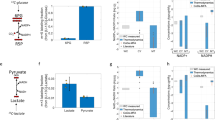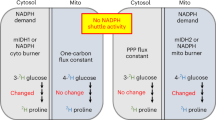Abstract
Oxidation–reduction (redox) reactions are ubiquitous in biology and typically occur in specific subcellular compartments. In cells, the electron transfer between molecules and organelles is commonly facilitated by pyridine nucleotides such as nicotinamide adenine dinucleotide phosphate (NADPH) and nicotinamide adenine dinucleotide (NADH). While often taken for granted, these metabolic reactions are critically important for maintaining redox homeostasis and biochemical potentials across membranes. While 13C tracing and metabolic flux analysis (MFA) have emerged as powerful tools to study intracellular metabolism, this approach is limited when applied to pathways catalyzed in multiple cellular compartments. To address this issue, we and others have applied 2H (deuterium) tracers to observe transfer of labeled hydride anions, which accompanies electron transfer. Furthermore, we have developed a reporter system for indirectly quantifying NADPH enrichment in specific subcellular compartments. Here, we provide a detailed description of 2H tracing applications and the interrogation of mitochondrial versus cytosolic NAD(P)H metabolism in cultured mammalian cells. Specifically, we describe the generation of reporter cell lines that express epitope-tagged R132H-IDH1 or R172K-IDH2 and produce (d)2-hydroxyglutarate in a doxycycline-dependent manner. These tools and methods allow for quantitation of reducing equivalent turnover rates, the directionality of pathways present in multiple compartments, and the estimation of pathway contributions to NADPH pools.
Access this chapter
Tax calculation will be finalised at checkout
Purchases are for personal use only
Similar content being viewed by others
References
Pollak N, Dölle C, Ziegler M (2007) The power to reduce: pyridine nucleotides--small molecules with a multitude of functions. Biochem J 402:205–218. https://doi.org/10.1042/BJ20061638
Williamson DH, Lund P, Krebs HA (1967) The redox state of free nicotinamide-adenine dinucleotide in the cytoplasm and mitochondria of rat liver. Biochem J 103:514–527
Veech RL, Guynn R, Veloso D (1972) The time-course of the effects of ethanol on the redox and phosphorylation states of rat liver. Biochem J 127:387–397. https://doi.org/10.1042/BJ1270387
Lunt SY, Vander Heiden MG (2011) Aerobic glycolysis: meeting the metabolic requirements of cell proliferation. Annu Rev Cell Dev Biol 27:441–464. https://doi.org/10.1146/annurev-cellbio-092910-154237
Diehn M, Cho RW, Lobo NA, Kalisky T, Dorie MJ, Kulp AN, Qian D, Lam JS, Ailles LE, Wong M, Joshua B, Kaplan MJ, Wapnir I, Dirbas FM, Somlo G, Garberoglio C, Paz B, Shen J, Lau SK, Quake SR, Brown JM, Weissman IL, Clarke MF (2009) Association of reactive oxygen species levels and radioresistance in cancer stem cells. Nature 458:780–783. https://doi.org/10.1038/nature07733
Schafer ZT, Grassian AR, Song L, Jiang Z, Gerhart-Hines Z, Irie HY, Gao S, Puigserver P, Brugge JS (2009) Antioxidant and oncogene rescue of metabolic defects caused by loss of matrix attachment. Nature 461:109–113. https://doi.org/10.1038/nature08268
Jeon S-M, Chandel NS, Hay N (2012) AMPK regulates NADPH homeostasis to promote tumour cell survival during energy stress. Nature 485:661–665. https://doi.org/10.1038/nature11066
Jiang P, Du W, Mancuso A, Wellen KE, Yang X (2013) Reciprocal regulation of p53 and malic enzymes modulates metabolism and senescence. Nature 493:689–693. https://doi.org/10.1038/nature11776
Young JD (2013) Metabolic flux rewiring in mammalian cell cultures. Curr Opin Biotechnol 24:1108–1115. https://doi.org/10.1016/J.COPBIO.2013.04.016
Dong W, Keibler MA, Stephanopoulos G (2017) Review of metabolic pathways activated in cancer cells as determined through isotopic labeling and network analysis. Metab Eng 43:113–124. https://doi.org/10.1016/J.YMBEN.2017.02.002
Badur MG, Metallo CM (2018) Reverse engineering the cancer metabolic network using flux analysis to understand drivers of human disease. Metab Eng 45:95–108. https://doi.org/10.1016/J.YMBEN.2017.11.013
Metallo CM, Walther JL, Stephanopoulos G (2009) Evaluation of 13C isotopic tracers for metabolic flux analysis in mammalian cells. J Biotechnol 144:167–174. https://doi.org/10.1016/J.JBIOTEC.2009.07.010
Zhao D, Badur MG, Luebeck J, Magaña JH, Birmingham A, Sasik R, Ahn CS, Ideker T, Metallo CM, Mali P (2018) Combinatorial CRISPR-Cas9 metabolic screens reveal critical redox control points dependent on the KEAP1-NRF2 regulatory Axis. Mol Cell 69:699–708.e7. https://doi.org/10.1016/j.molcel.2018.01.017
Maddocks ODK, Labuschagne CF, Adams PD, Vousden KH (2016) Serine metabolism supports the methionine cycle and DNA/RNA methylation through De novo ATP synthesis in cancer cells. Mol Cell 61:210–221. https://doi.org/10.1016/J.MOLCEL.2015.12.014
Ben-Sahra I, Hoxhaj G, Ricoult SJH, Asara JM, Manning BD (2016) mTORC1 induces purine synthesis through control of the mitochondrial tetrahydrofolate cycle. Science 351:728–733. https://doi.org/10.1126/science.aad0489
Lewis CA, Parker SJ, Fiske BP, McCloskey D, Gui DY, Green CR, Vokes NI, Feist AM, Vander Heiden MG, Metallo CM (2014) Tracing compartmentalized NADPH metabolism in the cytosol and mitochondria of mammalian cells. Mol Cell 55:253–263. https://doi.org/10.1016/j.molcel.2014.05.008
Fan J, Ye J, Kamphorst JJ, Shlomi T, Thompson CB, Rabinowitz JD (2014) Quantitative flux analysis reveals folate-dependent NADPH production. Nature 510:298–302. https://doi.org/10.1038/nature13236
Liu L, Shah S, Fan J, Park JO, Wellen KE, Rabinowitz JD (2016) Malic enzyme tracers reveal hypoxia-induced switch in adipocyte NADPH pathway usage. Nat Chem Biol 12:345–352. https://doi.org/10.1038/nchembio.2047
Badur MG, Muthusamy T, Parker SJ, Ma S, McBrayer SK, Cordes T, Magana JH, Guan K-L, Metallo CM (2018) Oncogenic R132 IDH1 mutations limit NADPH for De Novo lipogenesis through (d)2-hydroxyglutarate production in fibrosarcoma cells. Cell Rep 25:1018–1026. https://doi.org/10.1016/J.CELREP.2018.09.074
Chen L, Zhang Z, Hoshino A, Zheng HD, Morley M, Arany Z, Rabinowitz JD (2019) NADPH production by the oxidative pentose-phosphate pathway supports folate metabolism. Nat Metab 1:404–415. https://doi.org/10.1038/s42255-019-0043-x
Katz J, Rognstad R, Kemp RG (1965) Isotope discrimination effects in the metabolism of tritiated glucose. J Biol Chem 240:PC1484–PC1486
Rendina AR, Hermes JD, Cleland WW (1984) Use of multiple isotope effects to study the mechanism of 6-phosphogluconate dehydrogenase. Biochemistry 23(25):6257–6262
Zhang Z, Chen L, Liu L, Su X, Rabinowitz JD (2017) Chemical basis for deuterium labeling of fat and NADPH. J Am Chem Soc 139:14368–14371. https://doi.org/10.1021/jacs.7b08012
Ducker GS, Rabinowitz JD (2017) One-carbon metabolism in health and disease. Cell Metab 25(1):27–42. https://doi.org/10.1016/j.cmet.2016.08.009
Newman AC, Maddocks ODK (2017) One-carbon metabolism in cancer. Br J Cancer 116:1499. https://doi.org/10.1038/BJC.2017.118
Ducker GS, Chen L, Morscher RJ, Ghergurovich JM, Esposito M, Teng X, Kang Y, Rabinowitz JD (2016) Reversal of cytosolic one-carbon flux compensates for loss of the mitochondrial Folate pathway. Cell Metab 23:1140–1153. https://doi.org/10.1016/J.CMET.2016.04.016
Gao X, Lee K, Reid MA, Sanderson SM, Qiu C, Li S, Liu J, Locasale JW (2018) Serine availability influences mitochondrial dynamics and function through lipid metabolism. Cell Rep 22:3507–3520. https://doi.org/10.1016/J.CELREP.2018.03.017
Tibbetts AS, Appling DR (2010) Compartmentalization of mammalian Folate-mediated one-carbon metabolism. Annu Rev Nutr 30:57–81. https://doi.org/10.1146/annurev.nutr.012809.104810
Loeber G, Dworkin MB, Infante A, Ahorn H (1994) Characterization of cytosolic malic enzyme in human tumor cells. FEBS Lett 344:181–186. https://doi.org/10.1016/0014-5793(94)00386-6
Pongratz RL, Kibbey RG, Shulman GI, Cline GW (2007) Cytosolic and mitochondrial malic enzyme isoforms differentially control insulin secretion. J Biol Chem 282:200–207. https://doi.org/10.1074/jbc.M602954200
Wise DR, Ward PS, Shay JES, Cross JR, Gruber JJ, Sachdeva UM, Platt JM, DeMatteo RG, Simon MC, Thompson CB (2011) Hypoxia promotes isocitrate dehydrogenase-dependent carboxylation of α-ketoglutarate to citrate to support cell growth and viability. Proc Natl Acad Sci U S A 108:19611–19616. https://doi.org/10.1073/pnas.1117773108
Metallo CM, Gameiro PA, Bell EL, Mattaini KR, Yang J, Hiller K, Jewell CM, Johnson ZR, Irvine DJ, Guarente L, Kelleher JK, Vander Heiden MG, Iliopoulos O, Stephanopoulos G (2012) Reductive glutamine metabolism by IDH1 mediates lipogenesis under hypoxia. Nature 481:380–384. https://doi.org/10.1038/nature10602
Mullen AR, Wheaton WW, Jin ES, Chen P-H, Sullivan LB, Cheng T, Yang Y, Linehan WM, Chandel NS, DeBerardinis RJ (2012) Reductive carboxylation supports growth in tumour cells with defective mitochondria. Nature 481:385–388. https://doi.org/10.1038/nature10642
Jiang L, Shestov AA, Swain P, Yang C, Parker SJ, Wang QA, Terada LS, Adams ND, McCabe MT, Pietrak B, Schmidt S, Metallo CM, Dranka BP, Schwartz B, DeBerardinis RJ (2016) Reductive carboxylation supports redox homeostasis during anchorage-independent growth. Nature 532:255–258. https://doi.org/10.1038/nature17393
Dang L, White DW, Gross S, Bennett BD, Bittinger MA, Driggers EM, Fantin VR, Jang HG, Jin S, Keenan MC, Marks KM, Prins RM, Ward PS, Yen KE, Liau LM, Rabinowitz JD, Cantley LC, Thompson CB, Vander HMG, Su SM (2009) Cancer-associated IDH1 mutations produce 2-hydroxyglutarate. Nature 462:739. https://doi.org/10.1038/NATURE08617
Ward PS, Patel J, Wise DR, Abdel-Wahab O, Bennett BD, Coller HA, Cross JR, Fantin VR, Hedvat CV, Perl AE, Rabinowitz JD, Carroll M, Su SM, Sharp KA, Levine RL, Thompson CB (2010) The common feature of leukemia-associated IDH1 and IDH2 mutations is a Neomorphic enzyme activity converting α-ketoglutarate to 2-hydroxyglutarate. Cancer Cell 17:225–234. https://doi.org/10.1016/J.CCR.2010.01.020
Grassian AR, Parker SJ, Davidson SM, Divakaruni AS, Green CR, Zhang X, Slocum KL, Pu M, Lin F, Vickers C, Joud-Caldwell C, Chung F, Yin H, Handly ED, Straub C, Growney JD, Vander Heiden MG, Murphy AN, Pagliarini R, Metallo CM (2014) IDH1 mutations Alter citric acid cycle metabolism and increase dependence on oxidative mitochondrial metabolism. Cancer Res 74:3317–3331. https://doi.org/10.1158/0008-5472.CAN-14-0772-T
Cordes T, Metallo CM (2019) Quantifying intermediary metabolism and lipogenesis in cultured mammalian cells using stable isotope tracing and mass spectrometry. In: High-throughput metabolomics. Methods in molecular biology. Humana, New York, NY, pp 219–241
Yoo H, Antoniewicz MR, Stephanopoulos G, Kelleher JK (2008) Quantifying reductive carboxylation flux of glutamine to lipid in a brown adipocyte cell line. J Biol Chem 283:20621–20627. https://doi.org/10.1074/jbc.M706494200
Young JD (2014) INCA: a computational platform for isotopically non-stationary metabolic flux analysis. Bioinformatics 30:1333–1335. https://doi.org/10.1093/bioinformatics/btu015
Shin M, Momb J, Appling DR (2017) Human mitochondrial MTHFD2 is a dual redox cofactor-specific methylenetetrahydrofolate dehydrogenase/methenyltetrahydrofolate cyclohydrolase. Cancer Metab 5:11. https://doi.org/10.1186/s40170-017-0173-0
Kuri-Harcuch W, Wise LS, Green H (1978) Interruption of the adipose conversion of 3T3 cells by biotin deficiency: differentiation without triglyceride accumulation. Cell 14:53–59. https://doi.org/10.1016/0092-8674(78)90300-8
Aoki J, Taira A, Takanezawa Y, Kishi Y, Hama K, Kishimoto T, Mizuno K, Saku K, Taguchi R, Arai H (2002) Serum lysophosphatidic acid is produced through diverse phospholipase pathways. J Biol Chem 277:48737–48744. https://doi.org/10.1074/jbc.M206812200
Wang X, McManus M (2009) Lentivirus production. J Vis Exp 32:1499. https://doi.org/10.3791/1499
Benskey MJ, Manfredsson FP (2016) Lentivirus production and purification. Humana Press, New York, NY, pp 107–114
Acknowledgments
We thank members of the Metallo Lab for their feedback and discussion. C.M.M. is funded by NIH (R01 CA188652) and NSF CAREER (#145442) grants. E.W.L. is supported by a training grant from the NIH (T32 EB009380).
Author information
Authors and Affiliations
Corresponding author
Editor information
Editors and Affiliations
Rights and permissions
Copyright information
© 2020 Springer Science+Business Media, LLC, part of Springer Nature
About this protocol
Cite this protocol
Lim, E.W., Parker, S.J., Metallo, C.M. (2020). Deuterium Tracing to Interrogate Compartment-Specific NAD(P)H Metabolism in Cultured Mammalian Cells. In: Nagrath, D. (eds) Metabolic Flux Analysis in Eukaryotic Cells. Methods in Molecular Biology, vol 2088. Humana, New York, NY. https://doi.org/10.1007/978-1-0716-0159-4_4
Download citation
DOI: https://doi.org/10.1007/978-1-0716-0159-4_4
Published:
Publisher Name: Humana, New York, NY
Print ISBN: 978-1-0716-0158-7
Online ISBN: 978-1-0716-0159-4
eBook Packages: Springer Protocols




